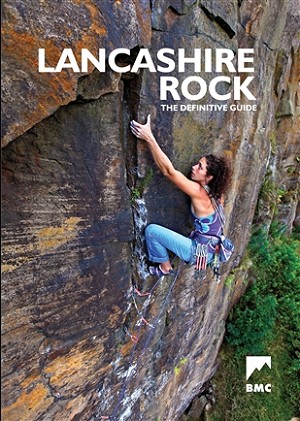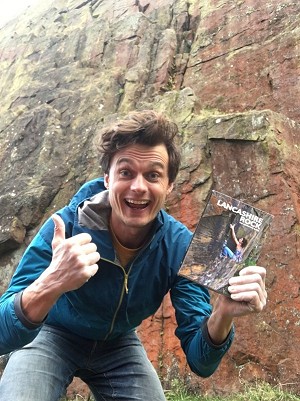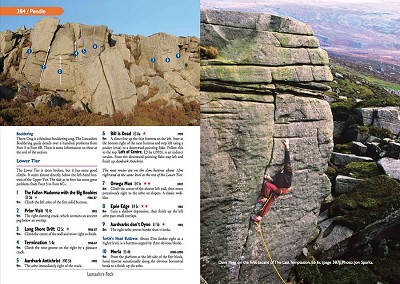

The last Lancashire guide was affectionately known as the ‘Brick’, so named because of its unique size. Contrary to my recent review of the Borrowdale guidebook, which sparked debate due to its increase in size, the new Lancashire Rock has actually gone down in size, despite an increase in the number of routes from 2950 in the 1999 'Brick' to 3200 in the new 'book'.
As we have come to expect from BMC guides in recent years, Lancashire Rock is adorned with a fantastic set of action shots, with some notable stand out images from Mike Hutton, Alex Messenger, Paul Evans, Robin Mueller, and Martin Kocsis in particular. The topos themselves are clear and colourful, no doubt testimony to the hours (days, years, and probably decades!) of effort from the team of volunteers that contributed to the guide’s production.
The guide contains the jewels in the crown of Lancashire climbing: Wilton, Anglezarke, and Egerton; but also - as alluded to within the opening paragraph, a lot, lot more. The limestone crags to the north, which include Farlton, Warton, Fairy Steps and Trowbarrow all make interesting stop-offs for anyone travelling the M6 (not to mention a good wet weather option for when it's raining in the Lakes). Thorn Crag is to my mind one of the finest - not to mention most underrated - gritstone outcrops around, with a fantastic circuit of boulder problems that match the quality of anything in either Yorkshire or the Peak. Finally, there are the unsung gems, of which this guide has a great many which have never had crag shots, topos, or action shots before. So there's something for both local and visitor, in equal measure.
To capture the spirit of the area, check out the film made during the 2016 WiltonFest:
Eager to put the guide through its paces, I took it for a 'test drive' to Wilton One a month ago. Having never visited the crag before, reviewing Lancashire Rock seemed like as good an excuse as any to go. Not only that, but I was inspired to go! En-route there was a slight hiccup, as the postcode on p.29 is incorrect* and sends you up somewhere near Clitheroe. Fortunately I noticed this way before my satnav sent me up onto the fells, but it did get me thinking - why use a postcode and not a set of GPS coordinates? Coordinates are a precise location, whereas postcodes are quite generalised. Speaking to the series editor Niall Grimes, he said he'd opted for postcodes on this occasion because they're a lot easier to use. This I cannot argue with, as coordinates - which contain more digits than my mind can remember in a single sitting - can be a bit unmanageable. What's more is that the exact location of the postcode is indicated on the maps by a blue star (something I hadn't realised), and being that the maps are not just clear, but large too, that finding your way to the crag is as easy as it can be. Another additional bonus of the size of the maps is that you can really get to grips with the canvas of the crags that surround you. Whilst climbing at Wilton I was actually quite surprised to see how close both Anglezarke and Egerton were, something I may not have gleaned otherwise.
*It’s also worth mentioning that I only found the one postcode that didn’t work, so was just quite unlucky!

When at the crag the quality routes weren't hard to find due to the use of stars, but I would have very much wished to know who climbed them first - was it Hank Pasquill? Ray Evans? Les Ainsworth? All names that are synonymous with the area in much the same way that Joe Brown, Pete Livesey, and Pat Littlejohn are in theirs. Names that can be relied on for quality. Whilst I am aware that much like the Peak Limestone North Guide, the absence of historic information came down to space within an ever growing guidebook, I still think its absence is a glaring omission and one that should be reconsidered for Peak Limestone South. My only hope is that the climbers of Lancashire decide to put together a historic tome in the same way that Peak climbers did with Peak Rock; I for one would buy a copy and I’m sure many others would too.
Criticism aside, and with an aim to move on to a slightly lighter note, I was very impressed with Wilton itself. Whilst the somewhat dank and green nature may be off-putting to some, scratch beneath the surface and you basically have an unsexy version of Millstone. It's a place I will certainly be re-visiting in 2017 and would highly recommend anyone who's a) bored of Millstone or b) much prefers cracks and edges to slopers and breaks, to get themselves down there too.
When it comes to bouldering, the guide is designed to be used in conjunction with Robin Mueller's Lancashire Bouldering Guide. Initially I'd found this a little confusing, as previous experience of BMC definitive guides had led me to expect both routes and problems; however, without wishing for another 'Brick' (or maybe even a breeze block) on our hands the task would have been impossible - it would have been far too large for a single volume. As a result, if it's routes you're after then look no further; but if it's bouldering you're after, check out the Lancashire Bouldering Guide (click here to read a review of the guide by Jordan Buys or here to read the guidebook author's superb destination article for the area) - I would heartily recommend it.
Overall
This is an inspirational guide that does a maligned and overlooked area full justice. Filled with fantastically clear topos, large maps, and a great many outstanding action shots, this is a guide that will inspire you to visit the area (if you haven't been) or to visit a new crag (if you have). Whilst the lack of history and first ascent information was a huge disappointment - this a personal gripe - it is a very good guide. That said, if bouldering is your thing it would be well worth investing in the Lancashire Bouldering Guide too.

The crags, unknown to many, scoffed at by a few, and ardently adored by a loyal and devoted band of local lovers, offer many of the best outcrop routes on grit. They are set conveniently smack in the heart of the urbanised north, and climbers from Lancaster, Preston, Bolton, Manchester and Liverpool could be deep within their muscular arms within forty minutes of leaving work on a spring evening. The new guidebook is the result of years of effort by the most committed of local climbers and is set to do for climbing in the county what Howard Carter did for King Tutankhamun. It will reveal the mythical crags, spoken of in hushed tones by the cognoscenti, to a waiting population of many. These waiting climbers will be amazed at the treasures that have lay hidden from them for so long, and will be dazzled at the beauty that awaits them. But maybe beauty is the wrong word. The thousands of routes that are covered in the new guide have character, brutality, charm, charisma, technical joy and a full-frontal fierceness all their own. These are not the delicate jewels found on the Eastern Edges. These are tough, hardworking climbs; nine-to-five and two weeks off in the summer. In short, they are brilliant routes on great crags.
















Comments